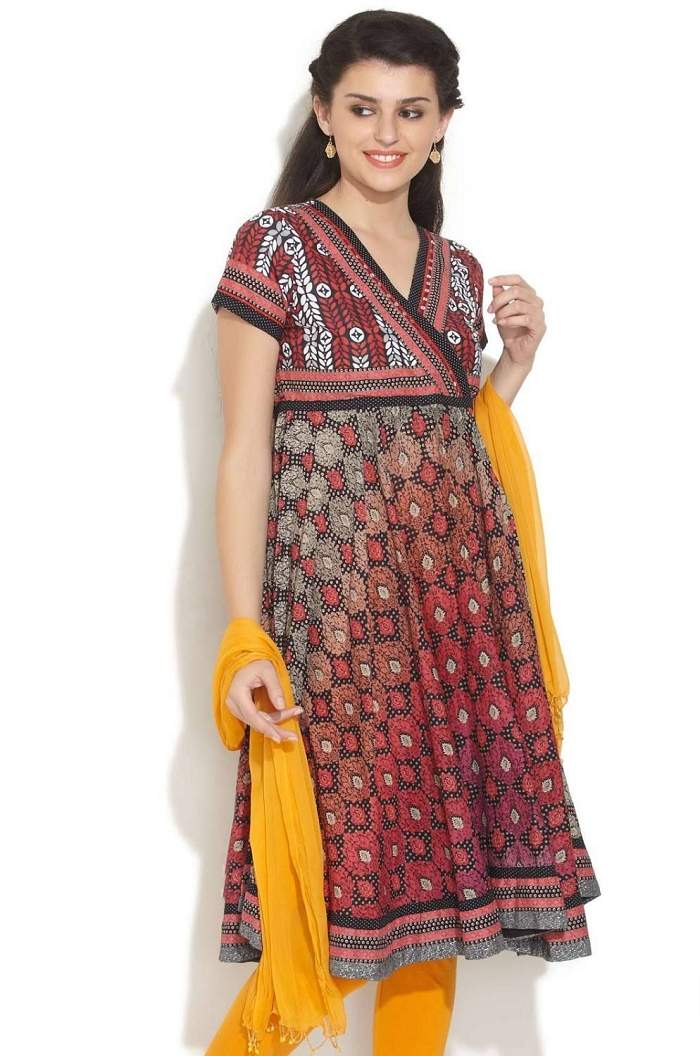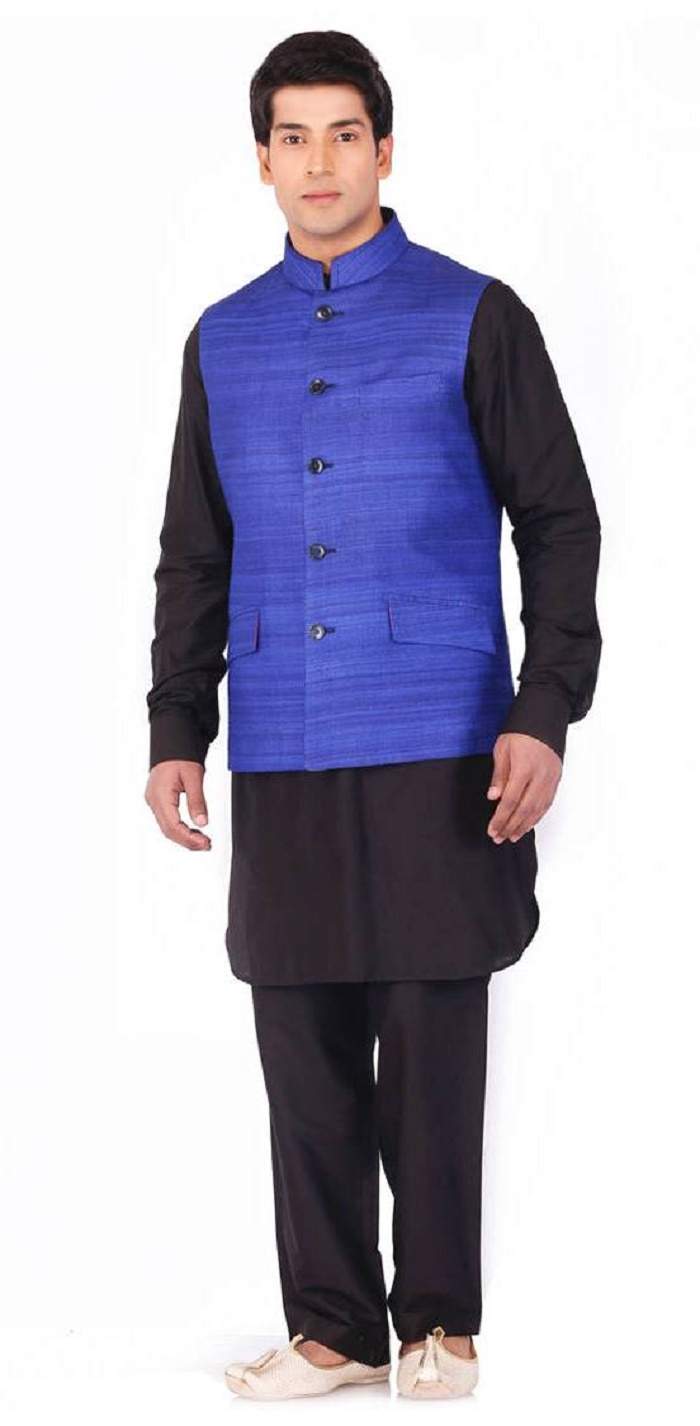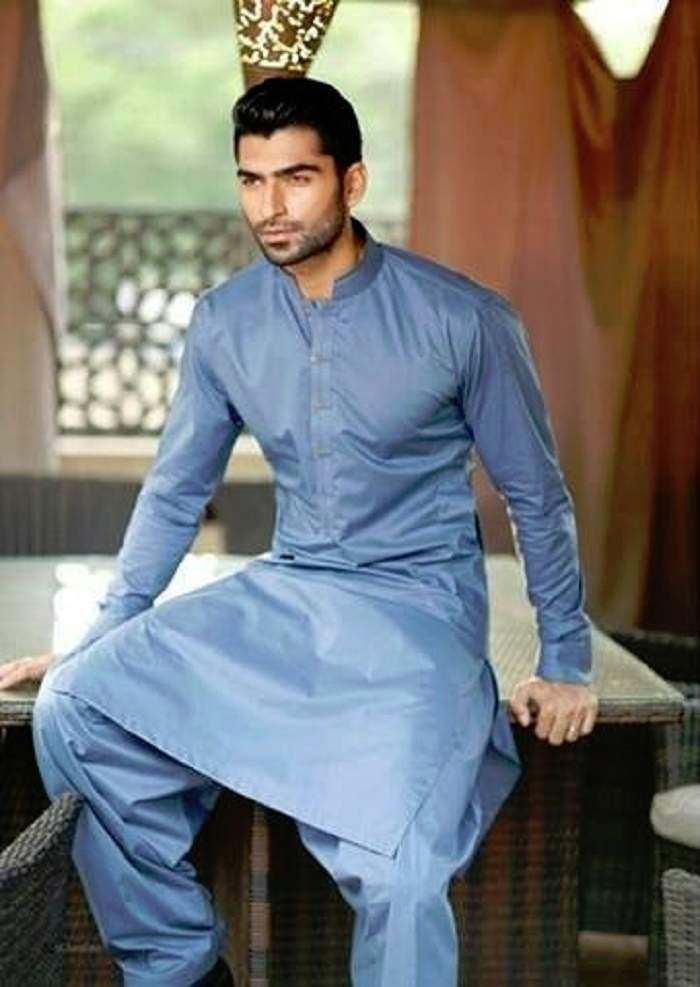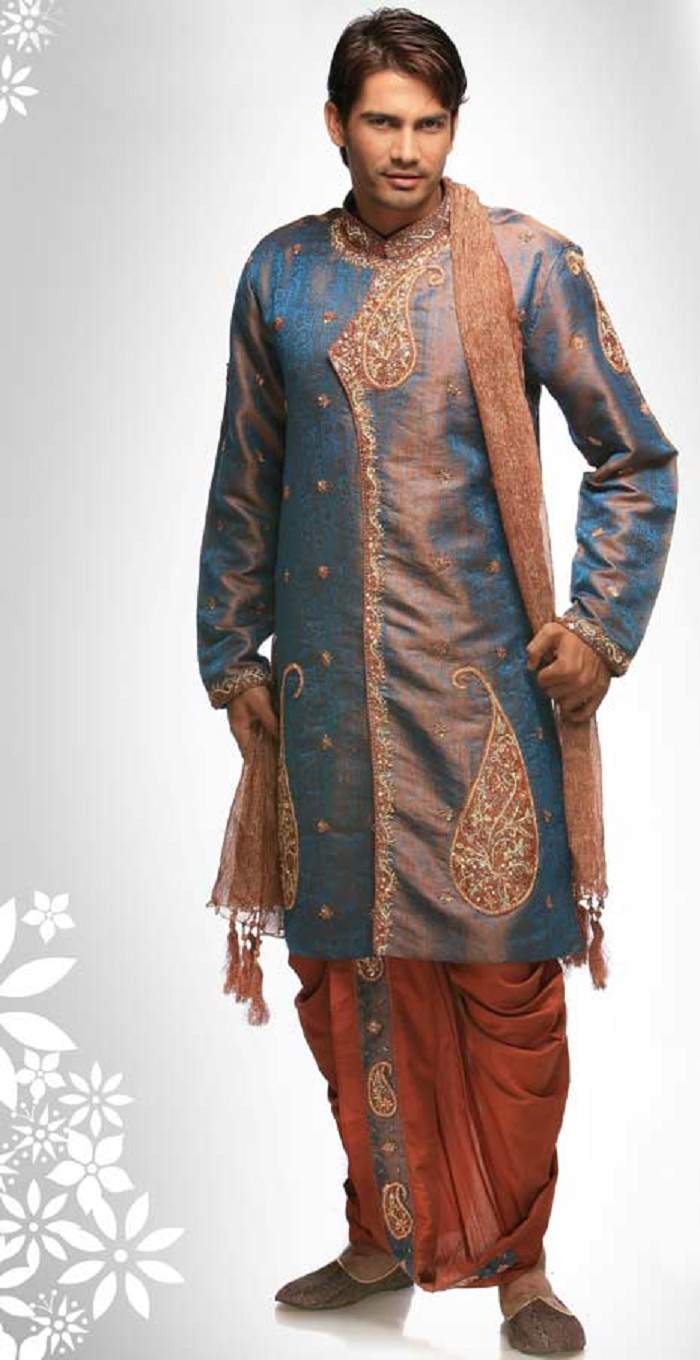Kurta is a long loose shirt, the length of which falls below or may be just above the knees of the wearer. In early times, it was primarily worn by men, but today, it has become a unisex dress that both men and women can wear. Depending on one's personal preference, the Kurta can be teamed with a churidar as well as a loose fit salwar. In the contemporary times, many youngsters don kurta along with a funky pair of jeans. It is a very flexible dress that can be worn on formal as well as informal occasions. Many even wear them at work. Most Indian men prefer wearing kurta pajama during the night and it is due to its extreme comfort that it has become a popular choice amongst the other nightwear available. Traditional Kurta-Pyjama is quite popular amongst the youngsters, who prefer wearing them in their informal social gatherings, with the basic idea of maintaining a distinctive style of their own.
An interesting thing about the Kurta is that its sleeves do not narrow down (as in the case of most of the sleeves designed in the western style) and fall straight to the wrist. A Kurta does not have cuffed sleeves and its side seams are left open for the easy movement of the wearer. The traditional Kurtas do not have any collar and their openings are usually centered on the chest. However, the modern Kurtas have undergone a major transformation and have stand up collars such as the Nehru collar.
During the summer season, Kurtas made up of light silk and cotton are in great demand, while during winters, people usually look for heavy fabrics such as wool, Khadi silk or may be handspun. Buttons used in the designing are mostly wooden or plastic. Kurtas are good for comfortable dressing and are great for both formal and casual occasions. They are undoubtedly classy and elegant, which is why they never go out of fashion.
Tracing The Roots Of The Kurta
The Indian subcontinent gave birth to the popular traditional attire - the Kurta. The word has its origins in the Urdu, Hindustani language and has also got the name from the Sanskrit word kuratu or kurtaka. In Persian it literally means a collarless shirt and it indeed is a collarless dress but some variants have a collar. The dress is commonly worn in countries such as Nepal, Pakistan, Afghanistan, and Sri Lanka along with India. It is worn with pajamas, pants, jeans, Dhoti and Lungis too and is stitched in fabrics like cotton, silk, voile, jute, khadi, and kota.
Kurtas are a part of ethnic wear and there are different varieties of Kurtas depending on their design and fabric. One type of Kurta is called as the Kali or the Kalidar Kurta that was inspired by the ghagraor lehnga style. It has rectangular panels on both the sides and several pieces are stitched together to give it a unique look, which is like a frock. These Kurtas are made of linen, cotton and silk.

Image Credit: http://www.hashmisays.com/wp-content/uploads/2015/10/1-Kali-Kurta.jpg
Different Types Of Kurtas
The Kalidar Kurtas are worn on occasions like a wedding or even worn as everyday wear. In the North Indian state of Uttar Pradesh, this design can be seen in the Chikan fabric and embroidery that is native of the state. The Nawabs of Lucknow in the popularized the embroidered Chikan Kurtas, which sell like hot cakes in foreign countries as well. Overlapping panels are the hallmark of the traditional Lucknowi Kurta. The Lucknowi Chikan Kurtas are also stitched in straight plain designs and form a part of the regular wear of people residing in the city due to the intensely hot weather during summers.

The Hyderabadi Kurta, which gets its name from Hyderabad, the capital city of the Indian state of Telangana, is also a form of the traditional Kurta. It can be distinguished by the presence of a keyhole neck opening and thread work near the collar part. Initially, the Hyderabadi Kurtas were made in white cloth but now coloured clothes are extensively used to stitch them. They are mostly worn on casual occasions.

Image Credit: http://www.hashmisays.com/wp-content/uploads/2015/10/33.jpg
Another Kurta style that gets its name from the region where it was born is the Bhopali Kurta, from the capital city of Madhya Pradesh- Bhopal. This Kurta is loose, has pleats at the waist and is long enough to reach below the knees but ends above the ankle. It is believed that influenced by the dress of Turkey, the Begum of Bhopal Sultan Jehan Begum introduced it. This type of Kurta is also worn with pajamas.

Image Credit: http://www.hashmisays.com/wp-content/uploads/2015/10/23.jpg
The Dogri Kurta from Jammu is open in the front and flares down to the knees. It can be paired with patialas or churidars and even chinos depending upon one’s preferance. If you feel like trying something different then the overlapping kurta could be a choice for you. It is unique in the sense that it resembles a mini gown and is not straight.

Image Credit: http://www.hashmisays.com/wp-content/uploads/2015/10/5.jpg
The straight cut Kurta, also known as the Punjabi Kurta, as the name suggests, is a straight cut Kurta whose hemline reaches the knees and has gusset inserts. These Kurtas are classified into three types depending on the embroidery, - the Muktsari Kurta from the province of Muktsar in Punjab, the popular Phulkari embroidered Phulkari Kurtas and the Kurta with bandhani patterns called the Bandhani Kurta.

The Sherwani Kurtas with rich embroidery and deep shiny colours are preferred for weddings and special occasions. They have sharp immaculately stitched shoulders with flares on the sides and are quite fancy. These Kurtas mainly have Mandarin collars and go well with churidar pajamas.
Another type of Kurta is the Pathani Kurta, which is worn on a regular basis in the regions of Punjab in North India. They look stylish with Patialas and look great on men with a good physique.
Crochete work has also found its way in the Kurta clothing line with the Multani Kurta that has designs of Multan (Pakistan) crocheted on it. It also makes use of Ajrak prints and is designed with a round neck and a buttonholes on one side of the shoulder. Another name of the Multani Kurta is the Saraiki Kurta.

Image Credit: http://www.hashmisays.com/wp-content/uploads/2015/10/9.jpg
The other ethnic Kurta is the Bengali Panjabi Kurta, which makes use of the famous indigenous Kantha embroidery of West Bengal and Bangladesh. These kurtas are rich in design and can be worn with jeans.

Image Credit: http://www.hashmisays.com/wp-content/uploads/2015/10/17.jpg
When it comes to traditional Kurtas, the Sindhi Kurta can’t be forgotten. It is a rich variant of the Kurta, which makes use of mirrors, and local patterns to embroider the fabric. The Bandhani textile decoration, which originated inSindh, is freely used in these Kurtas. This art spread to Gujarat via Rajasthan. Another variant of the Sindhi Kurta is the Rilli Kurta that makes use of heavy local material called Rilli.

Image Credit: http://www.hashmisays.com/wp-content/uploads/2015/10/15.jpg
Khadi Kurtas are also very popular in India and abroad. These kurtas are made from handspun and handwoven cloth, which has its origins in the Swadeshi movement, a during India’s struggle for freedom. The cloth is primarily woven from cotton but also includes silk and wool in it.It is also starched sometimes to give it a stiff look.
A Favourite With Women
Among women, the asymmetrical Kurta is quite a rage. It is short on the front and long at the back. It goes best with poly crepe fabric and an uneven hemline. It goes comfortably with pants and leggings or even a churidar pant. The other variety of kurta is the faux jacket kurta that has a jacket top done on the front. These kurtas go well with all body types and give a chic look to anyone who is wearing them.The layered or simple Anarkali Kurtas are a favourite with everyone. They are available in fabrics like net, georgette, crepe, cotton and silk too. Slightly similar to the Anarkali Kurtas are the frock Kurtas that have a flared hemline and look like frocks. While the Anarkali Kurtas are long and reach below the knees the frock ones end at the knees. Kurtas with collars are another variety of kurtas that fit well with churidars, pants and leggings. The collars could be broad like a shirt collar. Mandarin Peter Pan collars are also used to give kurtas a youthful look. The double layered and layered kurtas give that extra fluidity to the fabric and looks elegant with leggings or jeans.



